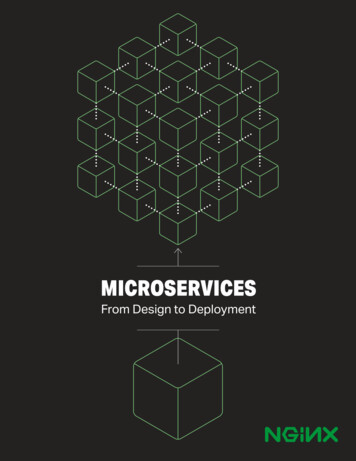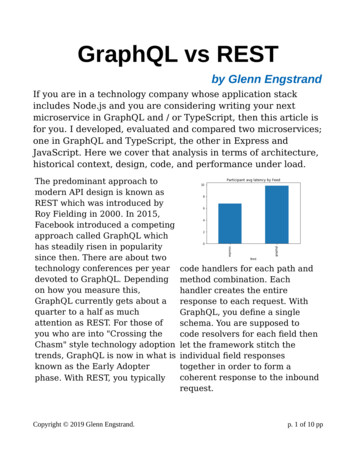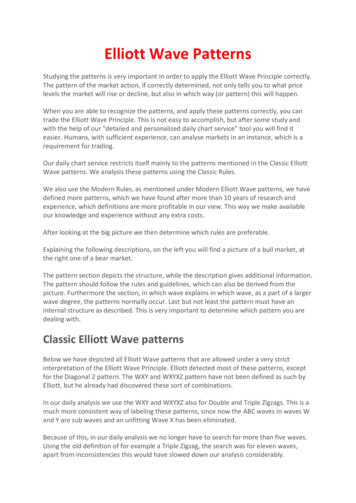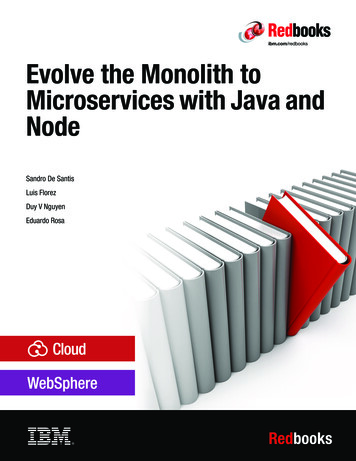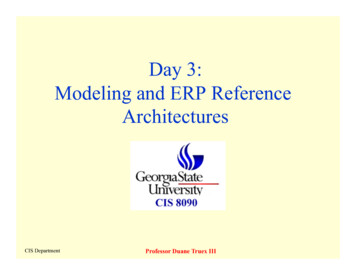
Transcription
Implementation Patterns for Microservices ArchitecturesKYLE BROWN, IBM CorporationBOBBY WOOLF, IBM CorporationAbstract In this paper we describe a set of implementation patterns for building applications using microservices. We discuss theapplication types and requirements that lead to the n eed for microservices, examine different types of microservices, and discuss patternsrequired for implementing data storage and devops in a microservices environment.Categories and Subject Descriptors: Software and its engineering Software design engineeringGeneral Terms: Software ArchitecturesAdditional Key Words and Phrases: Microservices, Agile Development, Pattern LanguagesACM Reference Format:Brown, K. and Woolf, B., 2016. Implementation Patterns of Microservices Architectures. HILLSIDE Proc. of Conf. on Pattern Lang. of Prog.22 (October 2016), 35 pages.1.INTRODUCTION: PURPOSE OF THE PATTERN LANGUAGEThe microservices architecture is one of the most rapidly expanding architectural paradigms incommercial computing today. Since its introduction in a white paper by Martin Fowler and JamesLewis [Fowler] it has since become a de-facto standard for developing large-scale commercialapplications.But despite the clear descriptions of the principles of this architecture in the Fowler whitepaper,and also in later works such as Newman’s that elaborate on the architecture, many developmentteams still struggle with basic practical questions about how to implement systems using themicroservices architecture. In particular, they struggle with questions of how the microservicesare invoked from a client application, how different client application styles affect theirmicroservices implementation, and, most important, how to build their microservices efficiently.It is that last point that is perhaps the most troublesome in practical microservicesimplementations. A benefit and a drawback of Services Oriented Architectures (including themicroservices approach) is that services are implemented as simple HTTP endpoints – but thesimplicity and power of HTTP is sometimes outweighed by the latency inherent in process-toprocess communication using HTTP. Overcoming that latency requires forethought and planningin your architecture in order to reduce unnecessary overhead.Another issue with microservices architectures is that while they make it possible for developersto have more choices – for instance, by allowing for both Polyglot programming and Polyglotpersistence -- in fact the set of choices facing developers is too large – with too few guidelines inplace for helping navigate. The result is that developers find it hard to decide where to start, andfind few good examples of template applications of different styles that use microserviceseffectively. In this paper, we will help address a few of those issues by introducing a set of simplePermission to make digital or hard copies of all or part of this work for personal or classroom useis granted without fee provided that copies are not made or distributed for profit or commercialadvantage and that copies bear this notice and the full citation on the first page. To copyotherwise, to republish, to post on servers or to redistribute to lists, requires prior specificpermission. A preliminary version of this paper was presented in a writers' workshop at the 23rdConference on Pattern Languages of Programs (PLoP). PLoP'16, OCTOBER 24-26, Monticello,Illinois, USA. Copyright 2016 is held by the author(s). HILLSIDE 978-1-941652-04-6
patterns that can help developers understand how to apply microservices in a variety of differentsituations.This paper is intended for use by Architects, Lead Developers or Senior Developers who arethinking about adopting the microservices architecture in their projects. It is intended to provideguidance on how microservices should be designed, how they fit into a larger architectural picture,and how they can be built to operate efficiently. While it specifically addresses issues of systemsdesign, microservices design and microservices efficiency, it does not cover issues of security ordevelopment process. Those nonfunctional requirements will have to be covered in later papers.1.1What is a Microservice?Microservices is an application architectural style in which an application is composed of manydiscrete, network-connected components, termed microservices. The microservices architecturalstyle can be seen as an evolution of the SOA (Services Oriented Architecture) architectural style.The key differences between the two are that while applications built using SOA services tendedto become focused on technical integration issues, and the level of the services implemented wereoften very fine-grained technical APIs, the microservices approach instead stay focused onimplementing clear business capabilities through larger-grained business APIs. An applicablerule in this case is that any microservice API should be directly related to a business entity.But aside from the service design questions, perhaps the biggest difference is one of deploymentstyle. For many years, applications have been packaged in a monolithic fashion – that is a team ofdevelopers would construct one large application that does everything required for a businessneed. Once built, that application would then be deployed multiple times across a farm ofapplication servers. By contrast, in the microservices architectural style, several smallerapplications that each implement only part of the whole are built and packaged independently.Microservices have applicability in both new application development and in refactoring. Whilemany teams prefer to apply the microservices approach in new or “greenfield” development, theapproach can be applied stepwise to existing applications as part of an application refactoringeffort. In cases like this, approaches such as Fowler’s “Strangler Application” [Fowler2] patternapply, although that lies outside of the scope of this paper.When you look at the implications of packaging services independently, you see that five simplerules drive the implementation of applications built using the microservices architecture. Theyare: Deploy applications as sets of small, independent services -- A single networkaccessible service is the smallest deployable unit for a microservices application. Eachservice should run in its own process. This rule is sometimes stated as “one service percontainer”, where “container” could mean a Docker container or any other lightweightdeployment mechanism such as a Cloud Foundry runtime, or even a Tomcat orWebSphere Liberty server.Optimize services for a single function – In a traditional monolithic SOA approach asingle application runtime would perform multiple business functions. In a microservicesapproach, there should be one and only one business function per service. This makesImplementation Patterns for Microservices Architectures: Page - 2
each service smaller and simpler to write and maintain. Robert Martin [Martin] calls thisthe “Single Responsibility Principle”.Communicate via REST API and message brokers – One of the drawbacks of the SOAapproach was that there was an explosion of standards and options for implementing SOAservices. The microservices approach instead tries to strictly limit the types of networkconnectivity that a service can implement to achieve maximum simplicity. Likewise,another rule for microservices is to avoid the tight coupling introduced by implicitcommunication through a database – all communication from service to service must bethrough the service API or at least must use an explicit communication pattern such as theClaim Check Pattern from [Hohpe].Apply Per-service CI/CD -- When building a large application comprised of manyservices, you soon realize that different services evolve at different rates. Letting eachservice have its own unique Continuous Integration/Continuous Delivery pipeline allowsthat evolution to proceed at is own natural pace – unlike in the monolithic approach wheredifferent aspects of the system were forced to all be released at the speed of the slowestmoving part of the system.Apply Per-service HA/clustering decisions – Another realization when building largesystems is that when it comes to clustering, not one size fits all. The monolithic approachof scaling all the services in the monolith at the same level often led to overutilization ofsome servers and underutilization of others – or even worse, starvation of some services byothers when they monopolized all of the available shared resources such as thread pools.The reality is that in a large system, not all services need to scale and can be deployed in aminimum number of servers to conserve resources. Others require scaling up to very largenumbers.The power of the combination of these points (each of which will be referenced in the patternsbelow) and the benefits obtained from following them is the primary reason why themicroservices architecture has become so popular.As an example of this approach, let’s look at a very simplified view of an airline website. Intraditional technologies, the only way to deploy an application would be as a monolith that isscaled to the maximum extent of any possible request – so if booking drove the most traffic toyour website, the entire application must be deployed as many times as you need just to handle thebooking traffic (see Figure 1: Traditional Monolithic deployment).Implementation Patterns for Microservices Architectures: Page - 3
BrowserMobileBrowserWeb serverMobileGatewayx60Customer GUICustomer Business LogicCustomerSQL DBRewardsNoSQLRewards GUIRewards Business LogicContentManagementBooking GUIBooking Business LogicLegacyAPIBookingLegacy DBFigure 1: Traditional Monolithic deploymentHowever, in a microservices approach, each individual business purpose; Booking Flights,Customer management, the Rewards program, etc., is broken down into separate microservicesthat can be deployed and managed independently. What’s more, you need only deploy as manycopies of each service as is actually required to handle the traffic for that specific business area.So, if Loyalty is only used by 10% of your customers, you may be able to deploy a drasticallysmaller number of servers for that business function than you would for flight booking. Anexample of this kind of architecture is shown below (see Figure 2: Airline application asmicroservices).Implementation Patterns for Microservices Architectures: Page - 4
Native cherCustomerServiceRewardsServiceCustomerSQL DBRewardsNoSQLWeb acheLegacyAPIBookingLegacy DBFigure 2: Airline application as microservices1.2How this pattern language is constructedThis pattern language is split into four parts; the first part, Modern Web Architecture Patterns,refers to those patterns that are helpful in understanding how the front end of an application builtusing a microservices Architecture can be effectively implemented. The second part,Microservice Architecture Patterns, refers to patterns specifically related to buildingMicroservices and making them run efficiently. The next part, Scalable Store Patterns, relate todecisions about data storage that are necessary to build systems that are both responsive andhighly available. The final part, Microservices DevOps Patterns discusses decisions aroundmanaging and debugging microservices applications.The patterns are written in a simplified POSA1 style with explicit sections for Context, Problem,Forces, Solution and Results.One of the lessons that we learned when writing Enterprise Integration Patterns [Hohpe] is thatwhen you are working in large problem domains there is often the need for a Root Pattern tointroduce the overall problem domain. That allows you to set the larger context of your domainwithout directly jumping into the details. Since our pattern language has four separate sectionsthat each describe a different aspect of the microservices approach, we need four root patterns. Inour pattern language we introduce each section with one of these four root patterns: Modern WebArchitecture, Microservices Architecture, Scalable Store and Microservices DevOps.1e.g. following the pattern style used in Pattern Oriented System Architecture [Buschmann]Implementation Patterns for Microservices Architectures: Page - 5
1.3Pattern MapThe following pattern map (Figure 3: Pattern Map) shows the split of the patterns into the foursections described above, as well as the connections between related patterns.Figure 3: Pattern Map2.MODERN WEB ARCHITECTURE PATTERNSAs described in the previous section, the Modern Web Architecture Patterns begin with the rootpattern Modern Web Architecture. Adopting a Modern Web Architecture will lead you todifferent potential implementation choices such as a Single Page Application or a Native MobileApplication. A Near Cache is commonly implemented in Modern Web Applications in order toimprove performance and to allow for some functioning when the client is disconnected fromback-end systems.Implementation Patterns for Microservices Architectures: Page - 6
2.1Modern Web ArchitectureTitle: Modern Web ArchitectureContext:You are building a new application or refactoring an existing application that needs to provide arich user interface that can be usable on many different devices such as smartphones, tablets, orlaptops.While the dynamic page approach is perhaps the most common application style on the Web,dating back to technologies like Active Server Pages (ASP), Java Server Pages (JSP), and PHP,the major drawback of this style is that the page-at-a-time semantics of these systems limit thetype of interfaces that can be effectively developed with them. It is difficult if not impossible towrite highly interactive user interfaces that take advantage of the user interface capabilities ofmobile devices, tablets and touchscreens using only the capabilities of HTML.Problem:How do you design an application that meets the needs of your users, while still working withinthe capabilities of the different interface devices that now exist?Forces: Web developers want to be able to take advantage of the capabilities of the JavaScriptengines built into modern web browsers.Modern Devices have more user-interaction capabilities than previous generations ofdevices that only supported mice and keyboardsUsers expect more from their applications and websites today than they did when the webwas first introduced.Solution:Adopt a Modern Web Architecture that combines intelligent front-end components with generalpurpose back-end components. In contrast to the page-at-a-time dynamic page solutions that werecommon in the early days of Browser technology, with Modern Web Architecture there is nolonger a need to have an explicit one-to-one map between a web page and a back-end server call.Picture:Implementation Patterns for Microservices Architectures: Page - 7
Native iOS orAndroidApplicationSwift orJavaBrowserJavascriptRetrieve HTML, CSS,Media, JavascriptQuery ContentServerFigure 4: Modern Web Architecture ComponentsIn the Modern Web Architecture (see Figure 4: Modern Web Architecture Components) you seethat there is a division between the front-end application (written in Javascript for a Single PageApplication, or written in Swift or Java for iOS or Android Native Mobile Applications) and theback-end Server logic. Essentially, this corresponds to a division between the “V” in a ModelView-Controller (MVC) Architecture, which can now remain entirely on the client side, and the“M” in the MVC, which can now remain mostly on the server side. Another aspect of the ModernWeb Architecture shown here is that most application now rely on a separate content server toprovide ephemeral aspects of the GUI (e.g. graphics, explanatory text, or even style sheets).Result:The Modern Web Architecture takes advantage of the fact that nearly all Browsers now supportJavascript as a client programming language. This allows you to make multiple back-end servercalls within the context of a single logical page. But the overall approach does not end at theBrowser. You can build intelligent front-ends either as Native Mobile Applications or Single PageApplications that interface with more general-purpose back-end services representing the serviceswithin a business domain, e.g. Business Microservices. By assuming that you can executeprograms at the client end then you can structure your architecture much more around serving datato an intelligent front-end application than around a specific user interface design. That allows thefront-end and the back-end to evolve at different rates. To facilitate this evolution, you can useImplementation Patterns for Microservices Architectures: Page - 8
Backends for Frontends where needed to adapt between the needs of specific Native MobileApplications, Single Page Applications and Business microservices. Near Caches can improvethe performance of your intelligent front-ends.Implementation Patterns for Microservices Architectures: Page - 9
2.2Single Page ApplicationTitle: Single Page ApplicationContext:You are developing a new web application or you are refactoring a section of a web application tomake it more modern.Problem: How do you design the front end of your application to take advantage of theprogrammability of modern browsers and provide the best mix of client responsiveness and serveroptimization?Forces: You want to provide the user with a very responsive application that they can interact witheasily despite network lags.You want the user to be able to interact with the application naturally, without arbitraryrestrictions in user interface design.You want to enable your designers to provide the cleanest, most attractive user interfacepossible, and to be able to make design modifications without requiring them to workthrough your development team.You want to allow your application developers to focus on application development issuesand not have to inordinately concern themselves with the minutiae of user interfacecomponent layout and design.Solution: Design your application as a Single Page Application using HTML5, CSS3 andJavaScript, which are natively implemented in modern browsers. Store page state within theclient and connect to the backend through REST services. This approach is called the “SinglePage Application” because all of the HTML, CSS and JavaScript code necessary for a complex setof business functions, which may represent multiple logical screens or pages, is retrieved as asingle page request. The JavaScript that manipulates the logical screens will handle all of themanipulation of the HTML DOM, the page navigation and the access to back end data.Picture:The following picture (Figure 5: SPA overview) shows the interaction between the differentcomponents of the Javascript within an SPA and the back-end systems that implement itcommunicates with.Implementation Patterns for Microservices Architectures: Page - 10
UI JavascriptData AccessJavascriptData Services(BFF)HTML, CSSBrowserServerFigure 5: SPA overviewResult: The main benefit of the Single Page Application approach is that it allows much moreresponsive and intuitive application designs than the dynamic page approach. JavaScript code thatexecutes within a web page can control not only the look and feel of the application by generatingand manipulating the client-side DOM in any way it chooses, but can request information from theserver at any point based on user interactions – resulting in more responsive user interfaces.Single Page Applications often are written to take advantage of Responsive Design principles (see[Brown]) to optimize user experience for screen layout and size. CSS Media queries are oftenused to include specific blocks that only apply for specific screen types. This technique allows adifferent set of CSS rules to be specified for tablets, mobile phones or laptops, resulting in screensthat are laid out and configured specifically for those devices.In a complex business application you may implement several Single Page Application instances.Each one represents a single logical set of screen interactions that perform a business function.This approach maps extremely well into the microservices approach, as you can match an SPA tothe capabilities of one or more Business Microservices. However, you may need to perform sometranslation or conversion of the results of a Business Microservice in order to match the uniqueuser interface requirements of your SPA.Implementation Patterns for Microservices Architectures: Page - 11
2.3Native Mobile ApplicationTitle: Native Mobile ApplicationContext: You are building applications that need to support on a variety of platforms. At thesame time, most of your customers are going to use a Mobile device as their primary means ofaccessing your application.Problem: How do you provide the most optimized user experience on a mobile device and takeadvantage of the features that make mobile computing unique?Forces: Mobile device capabilities change and evolve quicklyApplications that are built to emulate a mobile device look and feel often seem outdatedwhen the native user interface libraries of the Mobile OS changesMobile devices, while rapidly improving, often do not have the same processing capabilitythat larger desktop or tablet devices do.Solution: Write a Native Mobile Application for each of the two major platforms (iOS andAndroid).While Single Page Applications provide a good user interface that can be adapted to differentscreen sizes and orientations using Responsive Design no browser-based application can takeadvantage of all the features and capabilities of a mobile device. What’s more, even thoughadvances have been made in the speed and performance of Javascript in many browsers, theperformance of browser-based applications still noticeably falls behind those of nativeapplications. Another drawback of browser-based applications is that the user must remember tobookmark the webpage of the application – it is not present on their device home screen in thesame way that native applications are present.For these (and other) reasons, developers have found that constantly used, highly interactiveapplications, should be implemented as native applications using the tools and capabilities provideby the native development tool suite. This allows the developer to take maximum advantage ofthe platform’s capabilities, and at the same time allows users to easily locate and download theapplication through the platforms application store.That is not to say, however, that the two patterns can’t be used together. There are certainsituations in which it may not be absolutely required that you take advantage of the performanceof a Native Mobile application in all parts of a large mobile application. In those cases, a hybridapproach in which the most performance-intensive parts of the application are implemented usingnative mobile components, while the less performance-intensive pieces are implemented as aSingle Page Application that runs within an embedded mobile browser, may be an effectivetradeoff of development time for runtime performance.Implementation Patterns for Microservices Architectures: Page - 12
Result: Just as with Single Page Applications, microservices are a good match to Native mobileapplications since the business-oriented capabilities of a Business Microservice map cleanly to thecomplex screen flow and interaction capabilities of a Native mobile application.However, Native Mobile Applications have their own drawbacks that necessitate additionalarchitectural decisions – most notably the limited screen real estate of an application and thepotentially poor Internet connectivity over a mobile network may necessitate the use of otherpatterns such as a Near Cache or Backend for Frontend.Native Mobile Applications often are paired with Backend for Frontends that can filter andtranslate results to data format that are specific to the Mobile platform. Likewise, Native mobileapplications may benefit from a Near Cache when Internet connectivity is slow or unreliable.Implementation Patterns for Microservices Architectures: Page - 13
2.4Near CacheTitle: Near CacheContext: You are writing either a Single Page Application or a Native Mobile Application. Theapplication must be able to operate efficiently even when Internet connectivity is not available atthe highest speeds.Problem: How do you reduce the total number of calls to back-end microservices (particularlyBackend for Frontend’s) for repeated information?Forces: You don’t want to cross the network any more than necessary, especially when networkbandwidth is at a premium in a mobile device.You don’t want to make the user wait any more than is absolutely necessary.Solution: Use a Near Cache located within the client implementation. Cache the results ofcalling the Backend for Frontend services so as to reduce unnecessary round trips to the server.The simplest type of near cache is a globally scoped variable containing a hashtable data structure- something that is easily supported by JavaScript for Single Page Application or Java or Swift forNative Mobile Applications. However that may not always be the best solution -- for instance in aSingle Page Application, the application can also use HTML5 Local Storage for storage of cachedinformation.Near caches are easily implemented in Native Mobile Applications – for instance in iOS, CoreData or Property Lists can easily be used to store cached data locally. SQLite can be used on bothiOS and Android as a fast, local structured data store.Result: The benefit of a Near Cache is that it reduces the total number of times you must call aBackend for Frontend to retrieve repeated information. The drawback is that you must nowmanage the lifetime of the information in the cache to avoid it becoming stale, which can addcomplexity to your application code.Implementation Patterns for Microservices Architectures: Page - 14
3.MICROSERVICES ARCHITECTURE PATTERNSMicroservices Architecture Patterns deal with the nuts and bolts of identifying and implementingMicroservices. Microservices Architecture is the basic root pattern that you begin your designjourney by following. That will lead you to implement multiple Business Microservices. Youmay have to implement Adapter Microservices if you are required to communicate with existingback-end systems. The Backend for Frontends patterns is a key component for implementing aMicroservices Architecture in the context of a Modern Web Architecture in connecting differentclient types to your Business Microservices. Finally, Page Caches and Results Caches arecommonly used approaches to improve Microservice performance.3.1Microservices ArchitectureTitle: Microservices ArchitectureContext: You’re designing a server-side, multi-user application. You want your application to bemodular, and you want the modules to be independent. Your application modules need to becapable of composition, scalability, and continuous deployment.Problem: How do you architect an application as a set of independent modules?Forces: Modular code doesn’t tend to stay modular when it’s being developed by one big team andruns in one monolithic process. You don’t want to have to wait until development of all modules is complete in a largesystem before releasing some of the functionality if it is independently useful to thebusiness. When a single business function is divided into separate modules, those modules mustevolve in lockstep. Separate business functions can evolve at different rates. For a component to be modular, not only must its code be modular, but its data must beisolated and logically cohesive as well.Solution: Design the application with a Microservices Architecture, which is a set of moduleswhere each is an independent business function with its own data, developed by a separate teamand deployed in a separate process. For instance, a large retailing website may have separatemicroservices for different functions, such as catalog item search, cart checkout, and customerservice. These can be developed and released on different timelines.By developing a large application as a set of independent microservices, the individual servicescan be released and likewise evolve at their own pace. You don’t have to wait for the entiresystem to be complete before the business can begin to realize value from the system. There aredifferent styles of microservices for different needs, for instance adapting to existing systems vs.Implementation Patterns for Microservices Architectures: Page - 15
implementing new business logic, but all share the same traits of independent scaling andindependent development.In fact, the microservices approach gives you better control over scalability than a traditionalapproach can give you. By only scaling each microservice to the level at which they are requiredin order to handle the requests made for that specific service, you will be able to more efficientlyuse your computing resources than in the traditional model of scaling the entire monolith to thelargest number of instances needed to handle requests for the most commonly used functions.Result: Splitting up business functions into multiple small Business Microservices, allows eachmicroservice to be developed independently by a small team. Where you need to adapt anexisting interface such as a SOA service, you can write an Adapter Microservice. Backends forFrontends (BFFs) are used to mediate between different client types and Business Microservices.Microservices can be deployed independently with zero downtime for continuous deployment.Microservices can scale and fail independently. Microservices devel
2. MODERN WEB ARCHITECTURE PATTERNS As described in the previous section, the Modern Web Architecture Patterns begin with the root pattern Modern Web Architecture. Adopting a Modern Web Architecture will lead you to different potential implementation choices such as a Single Page

